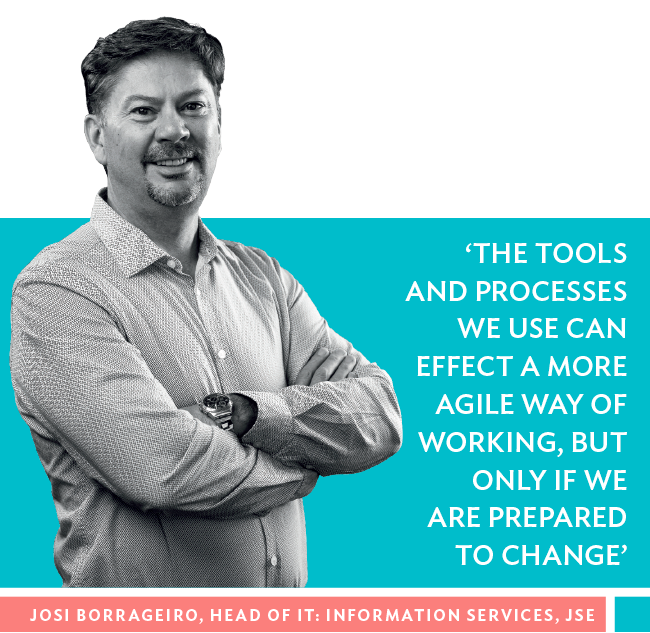Market disruptors have become commonplace as technology leads business into the future. This has intensified the need for organisations to become nimbler but this requires change, which is never easy to accomplish, nor quick to implement. This was shown to be the case at the JSE, whose IT division began its move towards the agile system several years ago. The basis for agile was conceived in Aspen in 2001 by a group of software developers. At its heart lie the concepts of ‘individuals and interactions over processes and tools; working software over comprehensive documentation; customer collaboration over contract negotiation; and responding to change over following a plan’. It has also been described as an ‘iterative development methodology that values human communication and feedback’.
Josi Borrageiro, JSE Head of IT: Information Services, explains that at the time, despite external consultants highlighting that change is hard, they took those words with a pinch of salt. ‘The reality is that it is very difficult to break habits of old and simply embrace the new, particularly when you are required to operate in both the old and new worlds of software delivery,’ he says. To really benefit from a change to agile required the leadership to make a strong commitment to the new culture and mindset, which the JSE embraced. Its Achilles heel, however, according to Borrageiro, was that the exchange was tackling complicated, complex projects using a hybrid delivery methodology – a mix of agile, iterative and waterfall – without the structure that agile demands.

Knowing this, and using the learnings and experiences of the IT department, the JSE appointed its agility partner in September 2019, in an endeavour to achieve a number of efficiency goals that benefit the JSE teams as well as the stakeholders. ‘Internally, agile will help us realise the full potential of our people by building an innovative, motivated, collaborative and happy workforce,’ says Borrageiro. ‘From a client perspective, we will be able to enhance the way we collaborate in finding solutions that represent value for them, and deliver that value in shorter time frames incrementally through multiple parallel initiatives. We also anticipate improvements in value-delivery turnaround time by decentralising decision-making, a key tenet of lean thinking and, in aligning to the scaled agile framework – a base of proven workflow patterns, integrated principles and practices – we will be able to drive sound investment and prioritise decisions.’
Although it’s early days, in the six months since the JSE introduced agile frameworks across part of the operation, 30% of the workforce has already been exposed to training and, according to Borrageiro, a far more collaborative environment for the teams working on the first scaled agile release train is evident. ‘We are implementing “change”, one agile release train at a time, with the intent to reflect and learn from the failures and successes, so that we continuously improve,’ says Borrageiro. ‘But we are somewhat hampered by not transforming on a more aggressive basis across more of the operations.’
However, agile as a method performs well when the requirements of a new initiative are not well defined and known. As Borrageiro describes, change in these circumstances is accepted at any stage, even at an increased cost. ‘Teams are dedicated to the delivery of incremental value, and time-to-market and delivery is now the preferred choice over long-running projects delivering a comprehensive working application full-feature set. Customers can also be included throughout the delivery life cycle of the priority initiatives.
Agile facilitated business and IT to have defined objectives, goals and plans with client inputs, and we are now including, from the outset, teams that would typically only have been involved in the later stages of a project. ‘Being wired to a sophisticated, scaled agile framework means the JSE can no longer be passively resistant or fall back on ways of old when we don’t trust that things can be done better or differently,’ says Borrageiro. ‘We acknowledge that the tools and processes we use can effect a more agile way of working, but only if we are prepared to change and be patient… We have a long journey ahead.’








